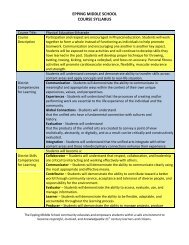Reading Standards for Informational Text & Literature - SAU 14
Reading Standards for Informational Text & Literature - SAU 14
Reading Standards for Informational Text & Literature - SAU 14
Create successful ePaper yourself
Turn your PDF publications into a flip-book with our unique Google optimized e-Paper software.
texts on the same topic (e.g., in illustrations,<br />
descriptions, or procedures)<br />
Range of <strong>Reading</strong> and Level of <strong>Text</strong> Complexity<br />
10. Actively engage in group reading activities<br />
with purpose and understanding.<br />
I can read non-fiction at my “just right” level.<br />
Grade One<br />
<strong>Standards</strong><br />
Key Ideas and Details<br />
1. Ask and answer questions about key details<br />
in a text.<br />
2. Identify the main topic and retell key details<br />
of a text.<br />
3. Describe the connection between two<br />
individuals, events, ideas, or pieces of<br />
in<strong>for</strong>mation in a text.<br />
Craft and Structure<br />
4. Ask and answer questions to help determine<br />
or clarify the meaning of words and phrases in<br />
a text.<br />
5. Know and use various text features (e.g.,<br />
headings, tables of contents, glossaries,<br />
electronic menus, icons) to locate key facts or<br />
in<strong>for</strong>mation in a text.<br />
6. Distinguish between in<strong>for</strong>mation provided by<br />
pictures or other illustrations and in<strong>for</strong>mation<br />
provided by the words in a text.<br />
Integration of Knowledge and Ideas<br />
7. Use the illustrations and details in a text to<br />
describe its key ideas.<br />
8. Identify the reasons an author gives to<br />
support points in a text.<br />
9. Identify basic similarities and differences<br />
between two texts on the same topic (e.g., in<br />
illustrations, descriptions, or procedures.)<br />
Range of <strong>Reading</strong> and Level of <strong>Text</strong> Complexity<br />
10. With prompting and support read<br />
in<strong>for</strong>mational texts appropriately complex <strong>for</strong><br />
grade 1.<br />
I can… Statements<br />
I can ask questions be<strong>for</strong>e, during, and after reading<br />
a story.<br />
I can identify a main topic and retell key details in a<br />
story.<br />
I can make text to text connections.<br />
I can make text to self connections.<br />
I can make text to world connections.<br />
I can read <strong>for</strong> meaning in non-fiction.<br />
I can find headings in non-fiction texts.<br />
I can find and use a table of contents.<br />
I can find a glossary.<br />
I can use a glossary with support.<br />
I can read pictures and labels in a non-fiction text.<br />
I can look at pictures to tell key ideas.<br />
I can read “fun facts” or insert boxes.<br />
I can learn new in<strong>for</strong>mation from more than one<br />
text.<br />
I can find the same in<strong>for</strong>mation from text to text.<br />
I can read non-fiction at my “just right” level.<br />
<strong>Reading</strong> <strong>Standards</strong> – In<strong>for</strong>mational <strong>Text</strong> and <strong>Literature</strong> Epping School District Page 2 of 16
















